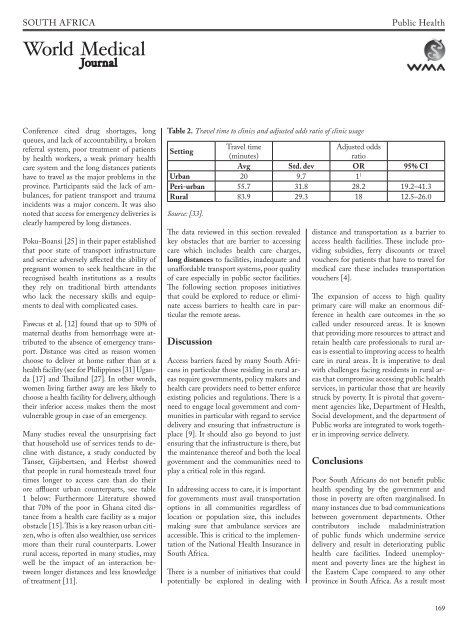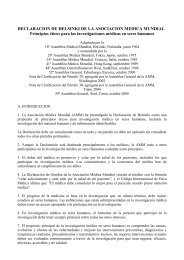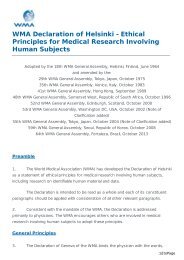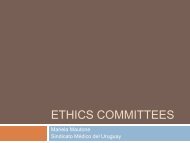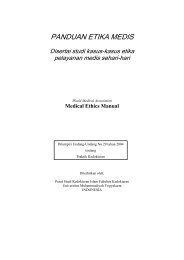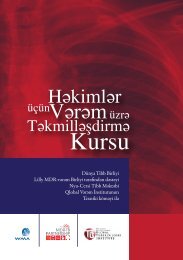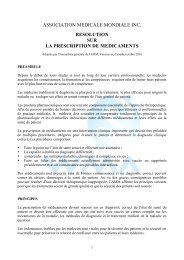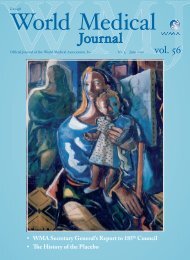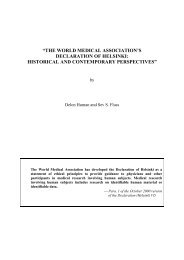WMJ 05 2011 - World Medical Association
WMJ 05 2011 - World Medical Association
WMJ 05 2011 - World Medical Association
Create successful ePaper yourself
Turn your PDF publications into a flip-book with our unique Google optimized e-Paper software.
SOUTH AFRICA<br />
Public Health<br />
Conference cited drug shortages, long<br />
queues, and lack of accountability, a broken<br />
referral system, poor treatment of patients<br />
by health workers, a weak primary health<br />
care system and the long distances patients<br />
have to travel as the major problems in the<br />
province. Participants said the lack of ambulances,<br />
for patient transport and trauma<br />
incidents was a major concern. It was also<br />
noted that access for emergency deliveries is<br />
clearly hampered by long distances.<br />
Poku-Boansi [25] in their paper established<br />
that poor state of transport infrastructure<br />
and service adversely affected the ability of<br />
pregnant women to seek healthcare in the<br />
recognised health institutions as a results<br />
they rely on traditional birth attendants<br />
who lack the necessary skills and equipments<br />
to deal with complicated cases.<br />
Fawcus et al. [12] found that up to 50% of<br />
maternal deaths from hemorrhage were attributed<br />
to the absence of emergency transport.<br />
Distance was cited as reason women<br />
choose to deliver at home rather than at a<br />
health facility (see for Philippines [31] Uganda<br />
[17] and Thailand [27]. In other words,<br />
women living farther away are less likely to<br />
choose a health facility for delivery, although<br />
their inferior access makes them the most<br />
vulnerable group in case of an emergency.<br />
Many studies reveal the unsurprising fact<br />
that household use of services tends to decline<br />
with distance, a study conducted by<br />
Tanser, Gijsbertsen, and Herbst showed<br />
that people in rural homesteads travel four<br />
times longer to access care than do their<br />
ore affluent urban counterparts, see table<br />
1 below: Furthermore Literature showed<br />
that 70% of the poor in Ghana cited distance<br />
from a health care facility as a major<br />
obstacle [15]. This is a key reason urban citizen,<br />
who is often also wealthier, use services<br />
more than their rural counterparts. Lower<br />
rural access, reported in many studies, may<br />
well be the impact of an interaction between<br />
longer distances and less knowledge<br />
of treatment [11].<br />
Table 2. Travel time to clinics and adjusted odds ratio of clinic usage<br />
Setting<br />
Travel time<br />
Adjusted odds<br />
(minutes)<br />
ratio<br />
Avg Std. dev OR 95% CI<br />
Urban 20 9.7 1 1<br />
Peri-urban 55.7 31.8 28.2 19.2–41.3<br />
Rural 83.9 29.3 18 12.5–26.0<br />
Source: [33].<br />
The data reviewed in this section revealed<br />
key obstacles that are barrier to accessing<br />
care which includes health care charges,<br />
long distances to facilities, inadequate and<br />
unaffordable transport systems, poor quality<br />
of care especially in public sector facilities.<br />
The following section proposes initiatives<br />
that could be explored to reduce or eliminate<br />
access barriers to health care in particular<br />
the remote areas.<br />
Discussion<br />
Access barriers faced by many South Africans<br />
in particular those residing in rural areas<br />
require governments, policy makers and<br />
health care providers need to better enforce<br />
existing policies and regulations. There is a<br />
need to engage local government and communities<br />
in particular with regard to service<br />
delivery and ensuring that infrastructure is<br />
place [9]. It should also go beyond to just<br />
ensuring that the infrastructure is there, but<br />
the maintenance thereof and both the local<br />
government and the communities need to<br />
play a critical role in this regard.<br />
In addressing access to care, it is important<br />
for governments must avail transportation<br />
options in all communities regardless of<br />
location or population size, this includes<br />
making sure that ambulance services are<br />
accessible. This is critical to the implementation<br />
of the National Health Insurance in<br />
South Africa.<br />
There is a number of initiatives that could<br />
potentially be explored in dealing with<br />
distance and transportation as a barrier to<br />
access health facilities. These include providing<br />
subsidies, ferry discounts or travel<br />
vouchers for patients that have to travel for<br />
medical care these includes transportation<br />
vouchers [4].<br />
The expansion of access to high quality<br />
primary care will make an enormous difference<br />
in health care outcomes in the so<br />
called under resourced areas. It is known<br />
that providing more resources to attract and<br />
retain health care professionals to rural areas<br />
is essential to improving access to health<br />
care in rural areas. It is imperative to deal<br />
with challenges facing residents in rural areas<br />
that compromise accessing public health<br />
services, in particular those that are heavily<br />
struck by poverty. It is pivotal that government<br />
agencies like, Department of Health,<br />
Social development, and the department of<br />
Public works are integrated to work together<br />
in improving service delivery.<br />
Conclusions<br />
Poor South Africans do not benefit public<br />
health spending by the government and<br />
those in poverty are often marginalised. In<br />
many instances due to bad communications<br />
between government departments. Other<br />
contributors include maladministration<br />
of public funds which undermine service<br />
delivery and result in deteriorating public<br />
health care facilities. Indeed unemployment<br />
and poverty lines are the highest in<br />
the Eastern Cape compared to any other<br />
province in South Africa. As a result most<br />
169


